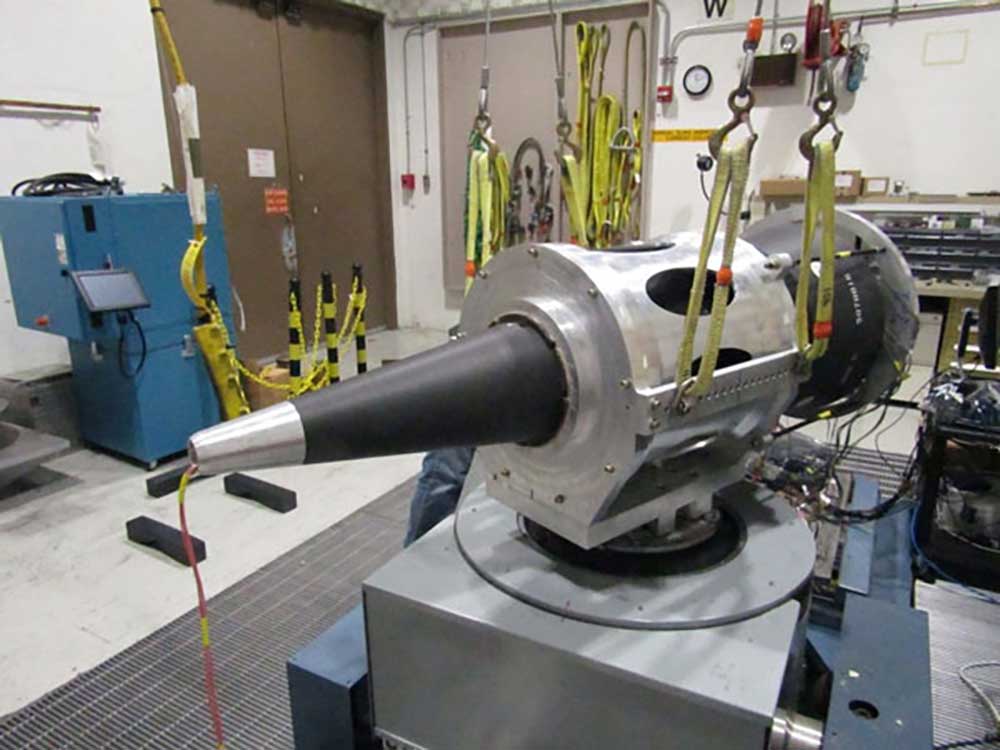
Sandia National Laboratories tests a prototype of the Mark 21 fuze to ensure it meets requirements and specifications. The first production unit of the fuze, which will be installed in a weapons system, was accepted in March. (Photo courtesy of Sandia National Laboratories)
Sandia’s work is helping modernize the U.S. nuclear deterrent
ALBUQUERQUE, N.M.— Sandia National Laboratories and the Kansas City National Security Campus completed a crucial weapons component development milestone, prior to full rate production.
The Mark 21 Replacement Fuze interfaces with the W87-0 warhead for deployment onto the Minuteman III and, eventually, the Sentinel Intercontinental Ballistic Missile.
The first production unit of the replacement fuze was approved through the National Nuclear Security Administration’s rigorous Quality Assurance Inspection Procedure in March.
The Mark 21 fuze, an integrated assembly of Sandia-designed logic and sensing devices, directs the warhead to initiate firing sequences at the correct point in targeting parameters. The Mark 21 Fuze Replacement Program is a Strategic Partnership Program effort between the NNSA and the U.S. Air Force.
“Sandia’s role is to deliver a fuze that meets the Air Force’s requirements. Completing the first production unit is a visible milestone in maintaining a credible deterrent,” said Brad Boswell, a director in Sandia’s nuclear deterrence modernization program. “It demonstrates that we are providing the necessary capability for the U.S. nuclear deterrent into the future.”
Designing the fuze
As the lead design agency of the Mark 21 fuze, Sandia was responsible for incorporating Air Force requirements into a form, fit, and functional package that interfaces with the Mk21 aeroshell, MMIII missile, and W87-0 warhead. Work began in 2011.
“The early engineering work takes a lot of time. While some of it is done in parallel, much of the work must be sequential,” said Bob Oetken, a former program manager for the fuze program. “We’re doing a very specific job that requires, in many cases, custom parts.”
Sandia worked closely with the Kansas City National Security Campus to ensure the design was producible and delivered on schedule. While the Kansas City National Security Campus is producing and assembling the fuze, Sandia is manufacturing some of the parts.
Fuze qualification
Before production of the fuze began, a significant amount of time was spent qualifying the design, which ensures the design meets Air Force specifications. It includes analysis through testing and other engineering tools to ensure the fuze will function as intended.
“Qualification involves significant resources and time. We are in a very rigorous business. Some of the qualification is used to verify that we are meeting requirements and took as long as three years from concept to delivery,” Oetken said.
The program has conducted numerous tests, including environmental, ground, and flight tests, to ensure the fuze withstands multiple difficult environments, such as acceleration, vibration, and thermal environments expected during missile launch and ballistic reentry.

Sandia National Laboratories is the lead design agency for the Mark 21 fuze. The program is a collaborative effort with NNSA, the Kansas City National Security Campus, and the U.S. Air Force. (Photo courtesy of Sandia National Laboratories)
Stockpile assessment
Now that the fuze is in full rate production, Sandia’s responsibilities shift.
“As the design agency, Sandia is responsible for the component until the weapon is retired. Sandia is accountable for ensuring that the weapon with the fuze attached is safe, secure, and reliable,” Boswell said.
As part of the stockpile assessment, Sandia will conduct surveillance through processes such as modeling and simulation, and flight and ground testing, to ensure the fuze continues to work as intended.
Partnering for great results
Completing the first production unit of the Mark 21 fuze is the culmination of more than a decade of work and collaboration, not just at Sandia, but by NNSA and the Department of Defense.
“This first production unit marks a significant milestone not just for Sandia but the broader nuclear security enterprise, particularly our partners at the Kansas City National Security Campus,” Boswell said. “While we stop to recognize this achievement, we must also acknowledge this is the start of the next phase of our partnership as we work to meet key production milestones to deliver the quantity of fuzes needed to meet the needs of the stockpile.”
Sandia National Laboratories is a multi-mission laboratory operated by National Technology and Engineering Solutions of Sandia LLC, a wholly owned subsidiary of Honeywell International Inc., for the U.S. Department of Energy’s National Nuclear Security Administration.
Sandia Labs has major research and development responsibilities in nuclear deterrence, global security, defense, energy technologies and economic competitiveness, with main facilities in Albuquerque, New Mexico, and Livermore, California.
Source:
